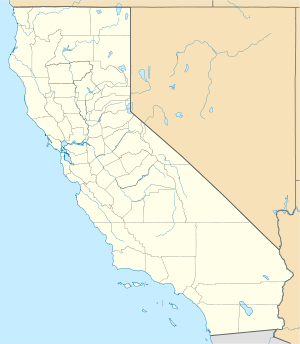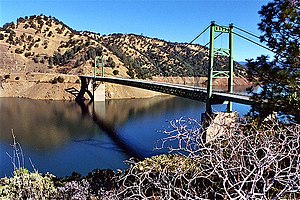Bidwell Bar Bridge
Coordinates: 39 ° 32 ′ 15 ″ N , 121 ° 27 ′ 15 ″ W.
| Bidwell Bar Bridge (1856) | ||
|---|---|---|
| The old Bidwell Bar Bridge (photo from 1984) | ||
| use | originally road traffic, now pedestrians | |
| Convicted | Oroville-Quincy Highway | |
| Crossing of | originally Feather River | |
| place | Oroville , California | |
| construction | Suspension bridge | |
| overall length | 75 m | |
| building-costs | $ 34,922 | |
| opening | 1856 | |
| location | ||
|
|
||
The Bidwell Bar Bridge is a suspension bridge in the state of California in the USA . Built in 1855 from the time of the California gold rush , the bridge is the only structure from the early days of suspension bridge construction that has survived on the west coast of the United States - albeit not in its original location, which was flooded by Lake Oroville Dam . It was therefore demolished in 1964 and rebuilt elsewhere. The Bidwell Bar Bridge is often referred to as the first suspension bridge west of the Mississippi .
history
In 1848 gold was found at Sutter's Mill - the find that started the gold rush in California. Shortly afterwards, John Bidwell also found gold at the Middle Fork of the Feather River . The discovery immediately brought crowds of fortune seekers to the site where the gold rush town of Bidwell Bar was formed. Originally, the river had to be crossed by ferry until a first toll bridge was opened in 1851 , which was destroyed in April 1852.
Original bridge
In 1854, the Bidwell Bridge Company was given permission to build a suspension bridge over the river. The construction was carried out by Jones & Murray of Sacramento and cost $ 34,922. Most of the wrought and cast iron parts came from the Starbuck Iron Works in Troy , New York . They had to be brought from the east coast to California by sea around Cape Horn .
The bridge was used at its original location until after World War II and was only demolished in 1964 because it would have sunk in the dammed Lake Oroville . After a short period of storage, the bridge was rebuilt in 1977 together with the toll house about 2.4 km from the original site on the bank of the reservoir at Kelly Ridge near a parking lot. The superstructure was sheltered with wooden posts to relieve the wire ropes. There is only water under the bridge when Oroville Lake is very full, otherwise the bridge is dry.
The original Bidwell Bar Bridge is a California Historical Landmark and a Historic Civil Engineering Landmark .
Bridge from 1965
| Bidwell Bar Bridge (1965) | |
|---|---|
| Today's Bidwell Bar Bridge (photo from 2006) | |
| overall length | 547 m |
| width | 8.5 m |
| Longest span | 338 m |
| Headroom | 8.8 m |
| Clear height | 191 m (during construction) |
| vehicles per day | 1500 vehicles per day (as of 2004) |
| opening | 1965 |
As a replacement for the old bridge, a suspension bridge above the water level of the Feather River was built a little upstream - about 180 m higher. Construction began in 1963 and opened in 1965. The order was carried out by Bethlehem Steel for $ 4.4 million. The building material was brought to the bottom of the valley by field railway and transported to the individual construction sites with a 580 m long cable crane . The suspension ropes were assembled without a catwalk from a gondola running on the cable crane, by unwinding and assembling two strands from a bobbin. The suspension cables were pre-tensioned before the reinforcement beam was installed.
The bridge with a span of 338 m was 191 m above the water level of the river at the time of construction, which made it the third tallest bridge in the world when it opened, only surpassed by the Royal Gorge Bridge and the Glen Canyon Bridge at the time . After the reservoir was flooded, only a small part of it remained visible. In addition to the Bidwell Bar Bridge, three other tall bridges cross Lake Oroville: the Enterprise Bridge , the West Branch Feather River Bridge and the Canyon Creek Bridge .
Building
Original bridge
The first Bidwell Bar Bridge is supported by four parallel wire ropes, each made of 300 wires with a diameter of 2.6 mm. The ropes are wrapped with forged wire and the whole wire rope is treated with paint. The ropes were originally anchored to curved bronze rods which were concreted in niches in the bank rocks. Each of the four pylons consists of four cast iron posts, which have a diameter of 50 cm at the base and are held together by a cross made of cast iron plates. The superstructure of the bridge is made of wood and has a lane .
Bridge from 1965
The new bridge high above the valley floor had to be anchored to the steep rocky slopes. The carriageway girder is only suspended between the pylons, while the driveways are designed as girder bridges , which lead in an arc out of the level of the supporting cables on both sides, which allowed the driveways to be routed more favorably. The stiffening girder has a construction height of 4.2 m, the concrete pillars of the 47 m high pylons are 55 m high. Each pylon is made of two welded box girders that are connected to one another by four truss yokes. Each of the two 42 cm thick suspension ropes consists of 38 laid strands and is provided with a covering system made of GRP , which for the first time replaced the traditional steel wire wrapping introduced for the Brooklyn Bridge on a suspension bridge .
Web links
Individual evidence
- ^ David Denenberg: Bidwell Bar Suspension Bridge. In: Bridgemeister . 2003, accessed October 19, 2014 .
- ^ Bidwell Bar Suspension Bridge. (No longer available online.) ASCE , archived from the original on October 31, 2013 ; accessed on October 14, 2014 (English). Info: The archive link was inserted automatically and has not yet been checked. Please check the original and archive link according to the instructions and then remove this notice.
- ^ Bidwell Bar Bridge. In: Bridgehunter . Retrieved October 21, 2014 .
- ↑ a b Richard Scott: In the Wake of Tacoma: Suspension Bridges and the Quest for Aerodynamic Stability . ASCE Publications, January 1, 2001, ISBN 978-0-7844-0542-0 , pp. 182-.
- ↑ Eric Sakowski: Bidwell Bar Bridge. In: HighestBridges.com. December 5, 2010, accessed October 21, 2014 .



